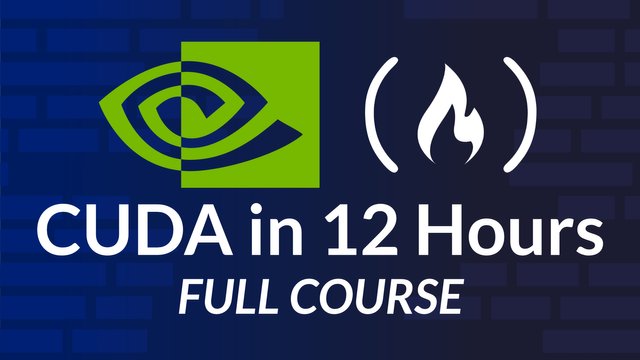CUDA (Compute Unified Device Architecture)

CUDA (Compute Unified Device Architecture) is a parallel computing platform and application programming interface (API) model created by NVIDIA. It allows developers to use a CUDA-enabled graphics processing unit (GPU) for general-purpose processing, an approach known as GPGPU (General-Purpose computing on Graphics Processing Units). Learning CUDA opens up a world of possibilities in fields such as scientific computing, data analysis, and machine learning, where performance and speed are critical.
We just posted a 12-hour CUDA course on the freeCodeCamp.org YouTube channel. This comprehensive course, created by Elliot Arledge, is designed to equip you with the skills needed to use the power of GPUs for high-performance computing tasks. Whether you're a beginner or an experienced programmer looking to expand your skill set, this course offers valuable insights into the world of CUDA programming.
Course Overview
The CUDA programming course is structured to guide you through the everything you need to know about GPU computing. Here's a detailed breakdown of what you can expect:
Introduction
The course kicks off with an introduction that sets the stage for what you'll learn. It provides an overview of the importance of GPUs in modern computing and how CUDA can be a game-changer in various applications.
Chapter 1: Deep Learning Ecosystem
Learn about the deep learning ecosystem and understand how GPUs play a crucial role in accelerating deep learning models. This chapter provides a foundational understanding of the tools and frameworks that leverage GPU power.
Chapter 2: CUDA Setup
Learn how to set up your environment for CUDA programming. This chapter covers the installation and configuration of necessary software, ensuring you're ready to start coding.
Chapter 3: C/C++ Review
Refresh your knowledge of C/C++ programming, which is essential for writing CUDA code. This chapter revisits key concepts and syntax to prepare you for GPU programming.
Chapter 4: Introduction to GPUs
Gain a deeper understanding of GPU architecture and how it differs from traditional CPUs. This chapter explains the parallel processing capabilities of GPUs and their advantages in high-performance computing.
Chapter 5: Writing Your First Kernels
Start writing your first CUDA kernels. This chapter introduces you to the basics of CUDA programming, including syntax and structure, enabling you to execute simple parallel tasks on the GPU.
Chapter 6: CUDA API
Explore the CUDA API in detail. Learn how to manage memory, launch kernels, and handle errors effectively. This chapter provides the tools you need to write efficient and robust CUDA programs.
Chapter 7: Faster Matrix Multiplication
Discover how to optimize matrix multiplication using CUDA. This chapter demonstrates techniques to enhance performance, a critical skill for applications in scientific computing and machine learning.
Chapter 8: Triton
Get introduced to Triton, a language and compiler for writing custom deep learning primitives. Learn how Triton can simplify the process of developing high-performance GPU code.
Chapter 9: PyTorch Extensions
Learn how to extend PyTorch with custom CUDA operations. This chapter shows you how to integrate CUDA code with PyTorch, enabling you to create custom layers and operations for deep learning models.
Chapter 10: MNIST Multi-layer Perceptron
Apply your knowledge by building a multi-layer perceptron to classify the MNIST dataset. This hands-on project consolidates your learning and demonstrates the practical application of CUDA in deep learning.
Chapter 11: Next Steps?
Explore potential next steps in your CUDA programming journey. This chapter provides guidance on further resources and projects to continue your learning and development.
Outro
The course concludes with an outro that recaps what you've learned and encourages you to apply your new skills in real-world projects.
Conclusion
Whether you're looking to enhance your career prospects or simply explore the fascinating world of GPU computing, this course is an excellent starting point.
Watch the full course on the freeCodeCamp.org YouTube channel (12-hour watch).